
|
Go to China Resources page
Go to Jordan's main page. Go to previous file, next file. |
Content Revised 2008-05-27 File last modified: |

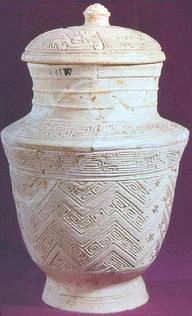 |
| Shāng Dynasty ceramic vessel from Tomb 331 at Ānyáng |
Among the groups lying to the east of the central Xià realm (specifically in Shāngdōng [SD] Province) were people known to history as "the Shāng" 商, who attacked the Xià, won, and became the Shāng Dynasty [period 03] under a leader called Tāng 汤 or Chéngtāng 成汤. Ancient writers count him as the first "king" of the Shāng Dynasty, under the dynastic title Tiān Yǐ 天乙 ("Second unto Heaven").
It was not easy. We are told that it took eleven expeditions and involved wiping out several other small groups. The decisive battle against the tyrant Jié was fought about 1600 BC at a place called Míngtiáo 鸣条 (near modern Kāifēng 开封 in Hénán (HEN) province.
With Jié defeated, Tāng established a "capital," we are told, at a nearby place named Bó 亳. (Some authorities suspect this was located at modern Shāngqiū 商丘 in Hénán [HEN]. Others argue that the ancient text is actually referring to a place called Western Bó 西亳, the present Yǎnshī 偃师, also in Hénán (HEN) Province, the site where the possible Xià "capital" of Èrlǐtóu is located.)
Chinese researchers today, pursuing the notion that the groups of people referred to by ancient writers were probably kinship-based "clans" or "tribes," each sharing a kind of "surname," interpret the record to suggest that the Shāng people shared the surname Zǐ 子, and that their genealogy centered on a rather shadowy ancestral figure named Xiè 契. (The character today means "a bond" and is pronounced qì in that meaning. It is sometimes mispronounced Qì when referring to the Shāng ancestor as well.)
Xiè was held to have been one of the subordinates of the sainted "emperor" Shùn from before the founding of the Xià Dynasty and to have been appointed an official in charge of waterworks under Yǔ, the unwitting founder of the Xià dynastic house. Bearing in mind that the Xià left no written records, and the Shāng scarcely any, we can nevertheless easily imagine the delicious irony that later writers would have found as the subordinate Shāng people, after generations of subjugation under the increasingly oppressive Xià, finally managed to take control.
Rather confusingly, the Shāng are said to have engaged during Xià times in a series of legendary migrations, perhaps as many as eight, although all within Hénán HEN and Shāndōng SD.
Two of the leaders of these movements were people named Xiāngtǔ 相土 and Wánghài 王亥, whom the Shāng royal house later honored as important ancestors. In its first three hundred years of existence after it was established, the Shāng régime is reported to have "moved" again, in this case by moving the "capital" settlement another five times.
Finally, probably about 1300 BC or so, King Pángēng 盘庚 [reign 03a-20] moved the Shāng capital to a place called Yīn 殷 (the present Ānyáng 安阳) in Hénán (HEN) Province, where it remained to the end of the dynasty nearly three hundred years later. For this reason, some earlier English writers used to speak of the "Yīn Dynasty." In Chinese the late Shāng is cometimes called the "Yīn Shāng" period.
Later tradition recounts that the reign of one king, King Wǔdīng 武丁 [reign 03a-23], was particularly glorious in his ability to subdue other tribes, and, in the absence of other evidence, his reign (if he existed) is considered to represent the maximum extent of Shāng expansion.
 |
| Modern marble "good luck" necklace in the form of a prehistoric jade bì. |
How about texts? Obviously it is frustrating to have no textual evidence from the Xià. In fact, we have very little indeed from the Shāng either.
What is clear from archaeology is that there was a substantial degree of "class" differentiation. It is reflected in differential tomb goods, and in the elaboration of luxury products of no known utilitarian value. An example is jade. Chinese uses the term jade (yù 玉) to refer to any of a range of shiny smooth stones, but all are characterized by being hard to find and hard to work. One never sees tools made of jade, but ornaments are common. In later times jade was sometimes considered to have healing powers, and a few jade objects may have had magical uses. Most, however, were clearly prestige items, with bigger and better pieces reflecting higher social status. (More About Jade)
By far the most common jade ornament was called a bì 璧. No-one knows what it was used for, but art museums around the world own examples of jade bì, and Chinese curio shops still sell small jade pieces in the same shape intended to be worm as ornaments or good-luck charms.
As far as we can reconstruct the situation today, it appears that the worship of the ancestors of the royal house represented a ritual act by which Shāng rulers asserted and celebrated the legitimacy of their political and economic domination of the region they were able to control. Important to this ritual system were the fabulously expensive bronze ceremonial vessels for which this dynasty and the succeeding Zhōu 周 dynasty are famed.
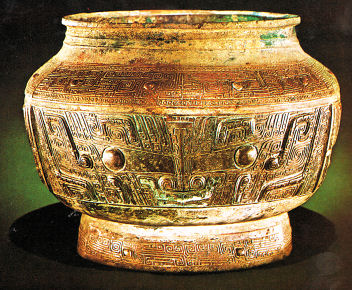 |
| Yīn (late Shāng) period bronze vessel from Gāochéngtáixī 篙城台西 in Héběi (HEB) Province |
The enormous labor that went into the design and production of jade and bronze luxury objects suggests that they were extremely important. The same view is suggested by the tradition that when nobles deserted the tyrant Zhòu at the time of the fall of the Shāng royal house, they carried with them bronze ritual paraphernalia, which they turned over to the attackers to facilitate the foundation of a new dynasty.
Was the Shāng a "theatre state"? Anthropologists sometimes speak of certain pre-modern states as "theatre states" (definition) because of their dependence upon public ritual to stress their relationship to cosmic realities and their right to rule. There is every reason to believe that there was such a tradition among the little states that grew up in China, which in order to sustain "theatre-state" governments, may have competed with each other in the production of bronzes and exploitation of copper mines,or earlier in the production of luxury ceramics and exploitation of clay sources. (The process of using theatrics to sustain political power is called "mystification." Click here for a brief essay on the subject.)
 |
| Elaborate bronze vessels like this square dǐng may have played a critical role in sustaining "theatrical" state power. |
Royal ancestors appear to have been special. It appears that the object of at least some of this ritual attention was the line of ancestors of the reigning monarch. Many specialists speculate that most Chinese in early antiquity did not worship their ancestors as they came to do in later times, although the non-worship of ancestors (or anything else) is not something that can readily be proven by archaeology. Rather, ancestor worship may have been a special feature of a reigning royal house. We do know that in Shāng times royal ancestors seem to have been very important because questions were put to them in divination of which we have records: the earliest coherent texts in Chinese history.
The divination was conducted using the scapulae (shoulder bones) of oxen and the plastrons (bottom shells) of turtles, a process called "scapulomancy." The divination involved applying heat to the bone or shell until it cracked, and then interpreting the direction of the crack. In some cases the questions being asked were engraved on the bones or shells. In a few cases, so were the answers.
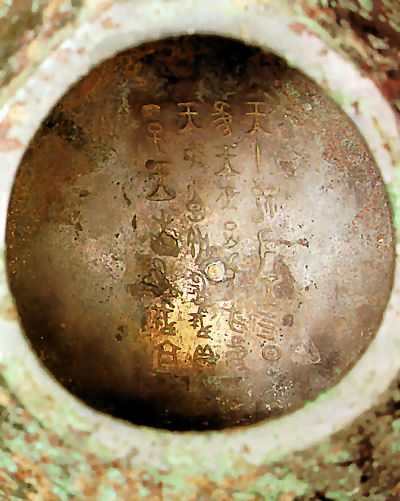 |
| Inscriptions on the inside of some bronze vessels give some information, including the system of names used to designate them. |
Modern scholars do not know what all of the symbols mean, although a few of them are obviously lineal ancestors of later Chinese writing. They enable us to see that the questions involve crops and weather and other concerns related to the welfare of the realm. But that is about all. Indeed, the questions seem rather prosaic compared to the fuss that was made over divining to learn the answers, once again suggesting that it was the symbolization of political power that was actually the point of the exercise.
 |
| Ox scapulae and tortoise plastrons were used in divination. By chance, they are our earliest documents in Chinese. |
Another element of the symbolization of political power was bronze ware. Curiously, even though we rarely know their exact function, we know the many names of the bronze vessels of various shapes because often there are inscriptions inside which identify them: "This dǐng 鼎 was made by so-and-so for so-and-so" doesn't tell us much about the vessel, but it does show that it was called a dǐng!
The characters used on the bronzes are similar to those on the oracle bones. It appears that some of these objects were presented to courtiers as a reward for service to the "king." But in other cases it appears that they were intended only for extremely limited use and only by the right people. (For a separate page on bronze vessels, click here.)
The most likely conclusion, both for the oracle bones and for the bronzes, is that the deities being consulted or commemorated were ancestors of the royal house, and the underlying issue was political legitimacy. Intersecting with this was the symbolization of wealth and prestige among subordinate members of the ruling elite.
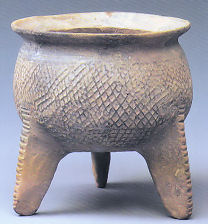 |
| Ceramic dǐng from Èrlǐtóu in Hénán (HN) Province |
The dǐng form seems in fact to have been rather special. For many Chinese the ultimate evidence of the political importance of the bronzes was the fact that Yǔ the Great was said to have had nine giant dǐng cast when he founded the Xià dynasty to symbolize state power in each of the nine segments into which his realm was divided. Further, strict sumptuary laws restricted how many dǐng might be used by different levels of courtiers in their sactifices.
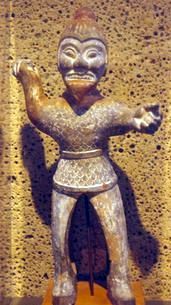 |
| Some students of ancient China are eager to see shamanism as a major force. This Hàn dynasty figurine has been regarded as a shaman with no evidence beyond an odd hat and beard, neither of which was necessarily demonstrably associated with shamanism. |
Some scholars, impressed by the importance of ritual and divination, speculate that diviners were important figures in the governance of these ancient states, both those that were mainstream dynasties and the countless small competitors that they eventually assimilated. Early sources speak of people called wū 巫 who apparently went into trance and performed healing or divination, possibly in the end related to the shamanic traditions of northeast Asia. (Definition) But there is no special reason to believe that it was the wū who performed state ritual or manipulated the oracle bones. Indeed, by late Zhōu times the wū seem already to have been held in very low regard, as have their successors throughout the rest of Chinese history down to the present.
Modern specialists have tried to piece together from such sources a "best-guess" view of the way in which the Shāng polity may have been organized, distinguishing an "internal" area 内服, which appears to have been directly controlled by the Shāng king, from various external regions 外服 that he controlled only indirectly. A possible third category might include more or less independent polities 方国 that paid only lip service at best to the Shāng monarch.
For the internal areas, it was possible to appoint officials to represent the king in governing them. For the external categories, it seems more likely that original "chiefs" or other local warlords were inevitable, and were linked to the royal house by the conferral on them of grandiose titles, in particular hóu 侯, sometimes translated "duke" or "lord," and diàn 甸, sometimes translated "marquis." As one might expect, they had a good deal of independence, which was greater in times when the central Shāng authority was weak.
(Official titles are difficult to translate exactly between languages, and especially when languages change over time. The five major terms used in later Chinese noble titles, with their conventional English translations, are: gōng 公 = "duke," hóu 侯 = "marquis, duke" bó 伯 = "count or earl," zǐ 子 = "viscount," nán 男 = "baron." Having two conflicting arbitrary conventions for rendering "hóu" in English — or "duke" in Chinese — does little to clarify Chinese history for English readers.)
The records list thirty-one Shāng kings, beginning with Tiānyǐ 天乙 and ending with a man with the reign name of Dìxīn 帝辛, known to history as King Zhòu 纣王.
This Zhòu, the last king of Shāng, like Jié, the last king of Xià, has always been seen by later historians as one of the great monsters of Chinese political history. He oppressed his subjects and ignored the advice of worthy and loyal ministers, and these features of his reign were especially vividly commemorated in a XVIth century (Míng 明 Dynasty [period 20]) novel, "Romance of Canonizations" 封神演义, that remains popular in countless retellings today (summary).
Full of all sorts of interesting mythological material, the novel builds on storytelling traditions dating back at least to the Sòng 宋 Dynasty [period 15] about the fall of the mad and evil King Zhòu of Shāng and the worthy succession of the next dynasty, the Zhōu. The underlying story, however, is clearly very much earlier than that. (Caution: It is easy in English to mix up evil King Zhòu 纣 and the Zhōu 周 dynasty [period 4], which was established by his conquerors. The pronunciation differs only in tone.)
Thus all Chinese readers know of King Zhòu's terrible treatment of his loyal ministers Bǐgān 比干, Wēizǐ 微子, and Jīzǐ 箕子, and of his great foolishness in ignoring their advice. And they have heard of his arrogance in offending the goddess Nǚwā 女娲 and of her sending seductive young she-demons to distract him from the affairs of state and bring about the destruction of the Shāng. Although the Romance of Canonizations has been much improved by the introduction of gods and demons, its underlying themes of the evil of King Zhòu and the ascent of the Zhōu dynasty are unchanged from remote antiquity.
Review Quiz over this page: Quiz 3.
Go to previous file, next file.